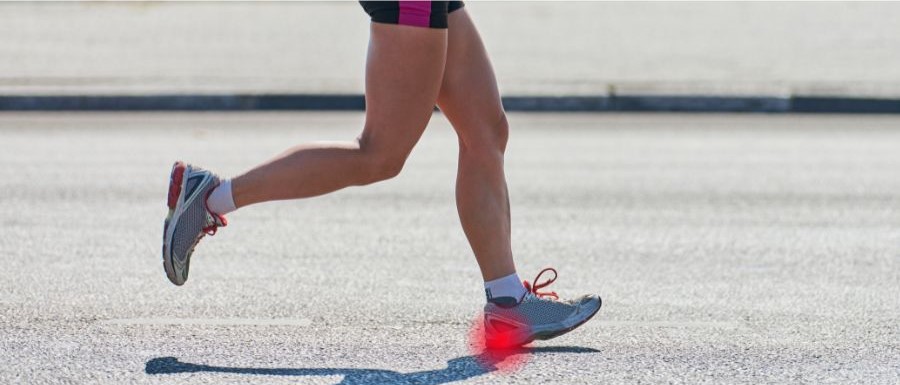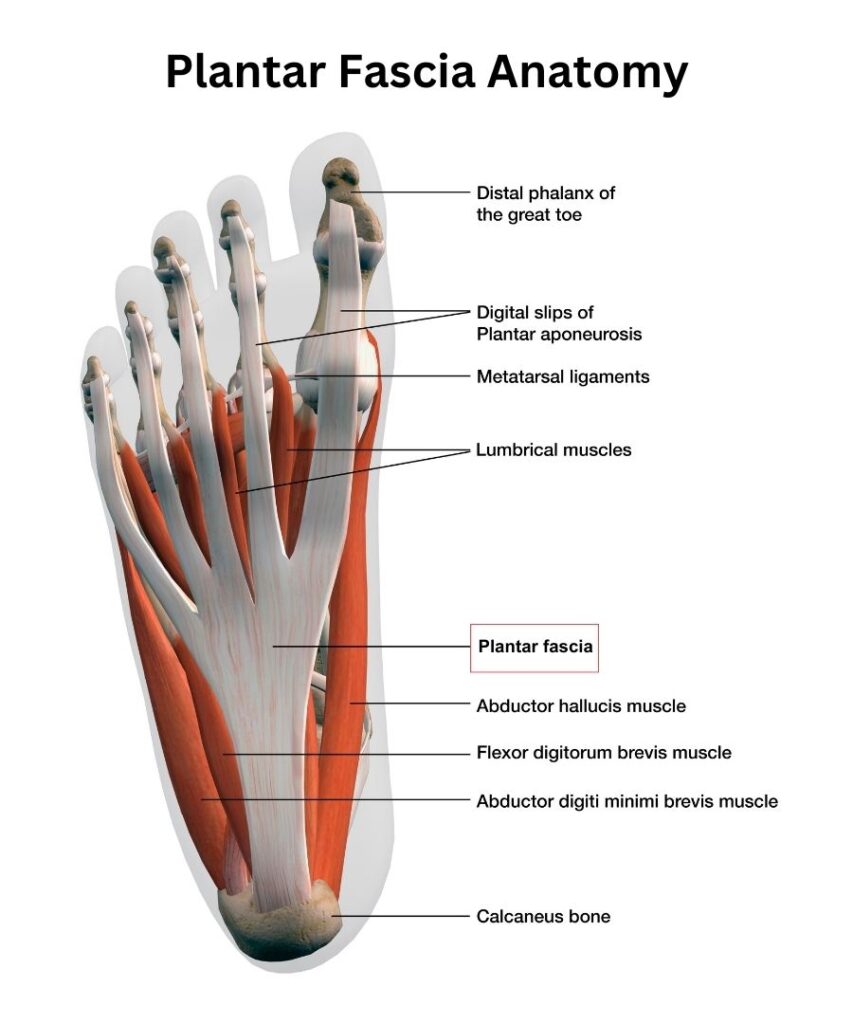
Plantar Fasciitis/Fasciopathy – The Most Common Cause Of Heel Pain In Runners
Plantar fasciitis/fasciopathy is a fairly common problem for runners of all abilities. It can really limit your ability to run, and may even force you to stop running for a while. Recovery can be fairly quick and simple if you manage it well in the early stages, but if left to progress and get worse it can be much harder to manage and take significantly longer.
Understanding the anatomy, symptoms, causes, and evidence-based management strategies is crucial for effectively dealing with heel pain during running. In this blog post, we will summarise what the latest research says and give you with insights and practical tips to manage plantar fasciitis/fasciopathy effectively.
What’s The Difference Between Plantar Fasciitis And Plantar Fasciopathy?
Before we start talking about what it is and how to manage it, we should review why the name has changed from plantar fasciitis to plantar fasciopathy. Plantar fasciitis was previously used as a general term for heel pain, but it’s not always technically correct. Plantar fasciopathy is the new, more correct name.
In medical terms, “itis” means inflammation. So plantar fasciitis means inflammation of the plantar fascia (just like “tonsilitis” means inflammation of the tonsils). The problem is, in many cases of heel pain, the plantar fascia is painful and irritated BUT there is not a significant amount of inflammation. Often there is more inflammation early on in the condition, but this fades away even though the pain may continue. So, to call every case of ongoing heel pain a fasciitis is not really correct.
Plantar fasciopathy is more the correct term because it covers pain from the fascia even though there may not be a significant amount of inflammation. In medical terms, “opathy” is broad term meaning dysfunction or disease – basically, just that there is something wrong with the structure. So plantar fasciopathy is a better term because it more accurately describes what’s happening with ongoing or chronic heel pain due to the plantar fascia
What is the Anatomy OF The Plantar Fascia?

The plantar fascia is a thick band of connective tissue that runs along the bottom of the foot, connecting the heel bone (calcaneus) to the toes. This fibrous structure plays a crucial role in maintaining the foot’s arch and acts as a shock absorber during activities like running. Think of the plantar fascia as like the roadway of the Sydney Harbour Bridge – it helps to hold the two ends of the arch together. As we land and take weight on our foot the 2 ends of the arch spread apart from each other and our arch drops a little, and the plantar fascia plays an important role in controlling this shock-absorbing mechanism.
What Are The Common Symptoms Of Plantar Fasciopathy In Runners
Plantar fasciopathy usually presents as sharp or stabbing pain in the heel, particularly during the first steps in the morning or after prolonged periods of rest. In the early stages the pain eases up as you get warm with activity or running, but may return later in longer running sessions. If the condition is allowed to progress further the pain doesn’t ease up even when you are warmed up, and this is often when people have to stop running altogether. Depending on how irritated your plantar fascia is, you may also feel more pain after long periods of standing or walking, especially if barefoot on hard surfaces.
What Causes Plantar Fasciopathy?
Several factors contribute to the development of plantar fasciopathy in runners. The most common one that our running physios see is increasing your running volume too quickly. This often happens in the few weeks or months prior to an event, eg the City2Surf or one of the various marathons that are so popular these days. It is often common with clients who are new to running, or who are returning to running after a break. In these cases load management, i.e. reducing your running volume to a level where your fascia can settle down, then gradually building it back up, is very effective if the condition is caught early.
Aside from increasing your running volume too quickly, the research suggests that several other factors can increase your risk of developing heel pain with running. These include;
1. Foot Mechanics: People with flat feet (excess pronation or pes planus) or high arches (pes cavus) are more likely to develop plantar fasciopathy. If you have flat feet your arch tends to collapse as you land and take weight on your foot, which pulls excessively on your plantar fascia and causes it pain as it attaches to your heel bone (calcaneus). If you have high arches your plantar fascia is usually very tight, and excessive loading during running will also cause a tension overload and pain.
2. A Lack Of Dorsiflexion: Dorsiflexion is the movement where your knee comes forward over your toes when you foot is on the ground (or, if your foot is off the ground, it’s the movement where your toes come back up towards your knee). Limited ankle dorsiflexion can change your foot mechanics and running gait, causing excessive load on your plantar fascia leading to plantar fasciopathy. Your dorsiflexion range can be reduced by either tight calf muscles, or by reduced ankle joint mobility, e.g. after an injury.
3. Training Errors: As well as increasing your overall running volume too quickly, other training factors like introducing hills and speed work too quickly can also increase your risk. This is because of the different biomechanics, gait patterns and tissue loading characteristics required for running hills and higher-speed intervals compared to flatter and more moderate-paced running. Once again, load management is usually effective in this situation when started early.
4. Inadequate footwear: The research is not conclusive on this area and there are various schools of thought. Basically, there is no “right” shoe that is best for everyone. Rather, it comes down to finding the right shoe for YOU. A great shoe for you may be terrible for someone else. There are so many reasons as to why this happens, but the easiest way to think about it is that if you have heel pain and aren’t sure if your shoes are a contributing factor, it’s a good idea to see a podiatrist or running physio, or go to a running shoe shop that has qualified people to check your running gait and foot mechanics, and get some proper advice.
5. Being Overweight: The research shows that carrying excess weight increases your risk of heel pain with running. This can be frustrating because many people want to start running as a way to help them lose weight! If this is the case with you then you may just have to start at lower volumes (e.g. walk 1 minute then jog for 1 minute, and repeat this for 15 minutes) and progress things more slowly, plus correct any of the other factors listed here to reduce your overall risk profile for developing plantar fasciitis.
6. Age: Plantar fasciopathy is most common in people aged between 40 and 60.
What Are The Best Ways to Manage Heel Pain And Plantar Fasciopathy?
1. Load Management
As outlined above, increasing your volume of running too quickly, or ramping up your hills and/or speed intervals too rapidly, is the most common cause that we see for heel pain in runners. The good thing is that if you start load management early, you may be able to self-manage things at this stage. If you are only just starting to feel some mild niggles then try just reduce your running volume, i.e. reduce the frequency or length of your runs, or reduce the hills or speed if you’ve recently pushed these up. If this doesn’t settle things then you can try a short (e.g. 1 week) break from running – it’s a great idea to cross-train on a bike during this period – and then start slowly again from a lower volume/intensity and see if things go ok. If this doesn’t work then it’s probably a good time to see your running physio.
2. Calf Stretches
Tight calf muscles can reduce your dorsiflexion range (see above), so doing stretches or using a foam roller may help
3. Strength Exercises
Strengthening up the muscles in your calf as well as some other muscles that are important for controlling your foot biomechanics (tibialis posterior, foot intrinsics) can be important in long-lasting relief from plantar fasciopathy. Increasing the strength of other muscles further up your kinetic chain, e.g. hip, pelvis and low back/core muscles, can also really help in some cases. For some examples of strength exercises that we use to treat plantar fasciopathy in runners click here.
4. Initial Ice Rolling
If your fascia is achy and sore after a run then rolling on a frozen bottle of water can give good temporary relief. It’s not really addressing the underlying cause, so you still need to look at other options, but it can really help settle things down if you’re sore after a run.
5. Have your Running Gait Assessed
Everyone has their own running gait, and there is a range of “normal”. But some factors of your running gait can be important when managing heel pain, especially if the pain is persisting or recurrent. So if you have already tried some of the simple strategies listed above, but your pain is persisting, then this is often a good time to have a running gait assessment.
6. Footwear And Orthotics
As mentioned above, there is no one shoe that is perfect for everyone. But there are guidelines and principles around what we expect to be the best shoe for you. So getting your foot posture and shoes checked by someone who knows about foot biomechanics and running shoes can be important for some people, especially if you have fairly flat feet or high arches. This process can also include seeing whether orthotics (moulded shoe inserts) can help. Usually a podiatrist or running physio can help you with this.
7. Taping
We can often tape your foot to relieve your pain temporarily and allow you to keep running at least at some level. This is not a long-term solution but it can be very helpful in some situations, e.g. if you have a race in a few days and you’ve just started getting some niggly heel pain, but you want to do the race then can manage things properly afterwards.
Need Help With Heel Pain?
Plantar fasciopathy can be a challenging condition for runners, but using the right management strategies EARLY is often really important and effective. Load management is often the most important factor, so using the above guidelines is usually a great place to start self-management of your heel pain. If this doesn’t work and you’d like some advice from one of our running team then click below to send us a question or book an appointment. Or feel free to call us on 9280 2322 to chat to one of our physios to see how we can help.

